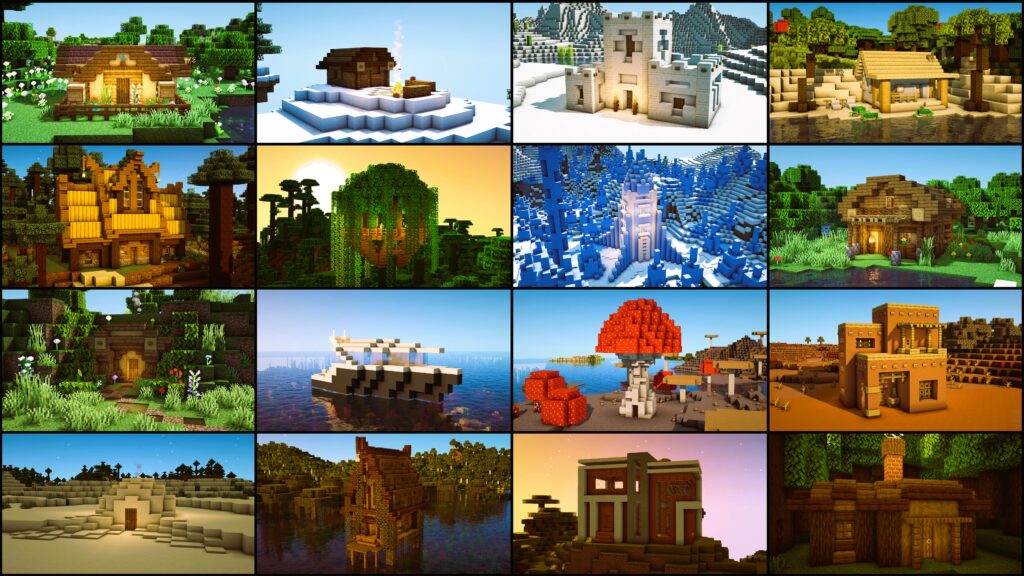In the vast and varied world of Minecraft, biomes play a crucial role in shaping the landscape and setting the stage for countless adventures. From lush forests and rolling hills to icy tundras and scorching deserts, each biome offers its own unique challenges and opportunities for builders. In this article, we’ll explore the art of building with biomes and discuss strategies for adapting your designs to different environments.
Understanding Biomes in Minecraft
Biomes are geographical regions in Minecraft characterized by distinct climates, terrain features, and types of vegetation. There are dozens of biomes in Minecraft, each with its own set of characteristics and environmental conditions. Some biomes, like forests and plains, are relatively hospitable, while others, like deserts and swamps, pose greater challenges to survival and construction.
One of the defining features of biomes in Minecraft is their biodiversity. Each biome is home to a unique array of plants, animals, and resources, which can vary widely depending on factors such as climate, elevation, and proximity to water.
Adapting Your Designs to Different Biomes
Building in Minecraft is all about adapting to your surroundings and making the most of the resources available to you. When designing and constructing buildings in different biomes, it’s important to consider factors such as climate, terrain, and available materials. Here are some strategies for adapting your designs to different biomes:
- Choose Appropriate Materials: Select building materials that are native to the biome you’re building in. For example, use wood from oak or birch trees in forest biomes, and sandstone or terracotta in desert biomes. Not only will this help your builds blend in with their surroundings, but it will also ensure that you have a ready supply of materials close at hand.
- Consider Climate Conditions: Take into account the climate of the biome when designing your builds. In colder biomes like taigas and snowy tundras, consider incorporating features like insulated walls, heated floors, and roofs pitched to shed snow. In hotter biomes like deserts and savannas, focus on creating shaded areas, maximizing airflow, and using materials that reflect heat.
- Work with the Terrain: Embrace the natural features of the biome when planning your builds. In hilly or mountainous biomes, consider building into the terrain or creating terraced structures to minimize the need for extensive terraforming. In flat biomes like plains and deserts, take advantage of the open space to create expansive builds or agricultural fields.
- Blend In with Nature: Incorporate elements of the surrounding environment into your builds to create a sense of harmony and cohesion. Use natural materials like grass, leaves, and flowers for landscaping, and incorporate features like ponds, rivers, and waterfalls to enhance the natural beauty of the biome. Strategies for organized and efficient urban development, more details in the article about Urban Planning.

Examples of Biome-Specific Builds
From cozy cottages nestled in forests to desert oases and arctic outposts, there are countless ways to adapt your designs to different biomes in Minecraft. Here are some examples of biome-specific builds to inspire you:
- Forest Hideaway: Build a rustic cabin or treehouse nestled among the trees of a dense forest biome, using materials like wood, stone, and foliage to create a natural and cozy retreat.
- Desert Oasis: Construct a tranquil oasis in the heart of a scorching desert biome, complete with palm trees, pools of water, and shaded courtyards to provide relief from the heat.
- Arctic Outpost: Establish a remote outpost in the icy wilderness of a snowy tundra biome, using materials like snow, ice, and packed ice to create a fortress against the cold.
- Tropical Paradise: Create a luxurious beach resort on the shores of a tropical island biome, featuring thatched-roof bungalows, hammocks strung between palm trees, and crystal-clear lagoons for swimming and snorkeling.
The Future of Building with Biomes
As Minecraft continues to evolve and expand, so too will the possibilities for building with biomes. From new biomes and terrain features to advanced building mechanics and environmental effects, the future of building in Minecraft is bright and full of possibilities.
For more information on biomes in Minecraft and building strategies for different environments, check out reputable sources like IGN.
In Minecraft, the world is yours to explore and shape. So pick up your pickaxe and get building – the adventure awaits!
